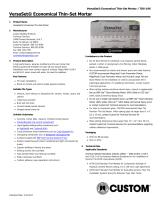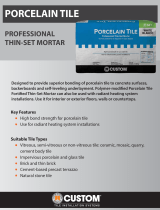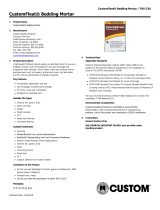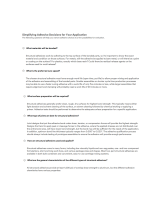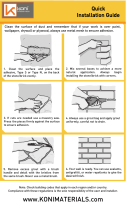CustomBlend®EconomicalNonModifiedThinSetMortar/TDS191
Resilient Floor Covering Institute (RFCI) "Recommended Work
Practices for Removal of Resilient Floor Coverings"
Tile Council of North America (TCNA) TCNA Handbook for Ceramic Tile
Installation, TCNA Method EJ171
Technical Chart
Property Test Method Requirement Typical Results
Pot Life
Open
Time
A118.1 Section 5.3 > 20 Minutes Pass
4 Week Shear Bond Strength
Mixed with Water
Glazed
Wall Tile
A118.1 Section 7.1 > 200 psi 225 - 300 psi
(15.821.1kg/cm²)
Porcelain
Tile
A118.1 Section 7.2 > 150 psi 150 - 225 psi
(10.515.8kg/cm²)
Mixed with Thin-Set Admix
Glazed
Wall Tile
A118.4 Section
5.1.5
> 300 psi 300 - 400 psi
(21.128.1kg/cm²)
Porcelain
Tile
A118.4 Section
5.2.4
> 200 psi 200 - 300 psi
(14.121.1kg/cm²)
Quarry
Tile to
Plywood
A118.11 Section
4.1.2
> 150 psi 150 - 200 psi
(10.514.1kg/cm²)
Environmental Consideration
Custom®BuildingProductsiscommittedtoenvironmental
responsibility in both products produced and in manufacturing
practices.UseofthisproductcancontributetowardsLEED®v3
certification:
Up to 2 points towards MR Credit 5, Regional Materials
Up to 2 points towards MR Credit 4, Recycled Content
Upto1pointtowardsIEQCredit4.1,LowEmittingMaterials–
Adhesives & Sealants
5 Instructions
General Surface Prep
USE CHEMICAL-RESISTANT GLOVES, such as nitrile,
when handling product.
Surfaces must be structurally sound, clean, dry and free from grease,
oil, dirt, curing compounds, sealers, adhesives or any other
contaminant that would prevent a good bond. Glossy or painted
surfaces must be sanded, stripped and cleaned of waxes, dirt or any
contaminants. Concrete must be cured 28 days and accept water
penetration. Concrete must be free of efflorescence and not subject to
hydrostatic pressure. Concrete slabs should have a broomed or
brushed finish to enhance the bond. Plywood flooring including those
under resilient flooring must be structurally sound and meet all ANSI
and deflection requirements. For questions about proper subfloor
installation, call Technical Services. Smooth concrete surfaces, existing
glazed tile, terrazzo, or polished stone should be roughened or
scarified. Sheet vinyl must be well-bonded and stripped of old finish.
Roughen the surface by sanding or scarifying, rinse and allow to dry.
Expansion joints should never be bridged with setting material. Do not
sand flooring materials containing asbestos. Ambient temperature,
surfaces and materials should be maintained at a temperature above
50°F(10°C)orbelow100°F(38°C)for72hours.
Bonding to Concrete Surfaces
Concrete or plaster must be fully cured and must accept water
penetration. Test by sprinkling water on various areas of the substrate.
If water penetrates, then a good bond can be achieved; if water
beads, surface contaminants are present, and loss of adhesion may
occur. Contaminants should be mechanically removed before
installation. Concrete must be free of efflorescence and not subject to
hydrostatic pressure. Concrete slabs should have a broomed or
brushed finish to enhance the bond. Smooth concrete slabs must be
mechanically abraded to ensure a good bond.
Bonding to Plywood Surfaces
Plywood floors, including those under resilient flooring, must be
structurally sound and must meet all ANSI A108.01 Part 3.4
requirements. See TCNA F150 tile installations, TCNA F141 and F250
for stone. For questions about proper subfloor installation
requirements,callCustom®TechnicalServices.
Bonding to Backerboards
Asanalternativetoanadditionallayerofplywood,WonderBoard®
backerboard may be installed over plywood subfloors. Refer to TCNA
F144tileinstallations,TCNAF250forstone.CallCustom®Technical
Services when installing natural stone over plywood subfloor.
Bonding to Existing Surfacing Material
Existing Ceramic Tile, Resilient Flooring or Plastic Laminates: Resilient
flooring or plastic laminates must be well-bonded, as well as clean and
free of all contaminates. Roughen the surface by sanding or scarifying;
rinse and allow to dry. Do not sand flooring that contains asbestos. For
existing well-bonded ceramic tile, mechanically abrade the surface.
Rinse and allow to dry. When sanding, an approved respirator should
be used.
Bonding to Cutback Adhesive
Adhesive layers must be removed, as they reduce mortar bond
strength to cement surfaces. Use extreme caution; adhesives may
contain asbestos fibers. Do not sand or grind adhesive residue, as
harmful dust may result. Never use adhesive removers or solvents, as
they soften the adhesive and may cause it to penetrate into the
concrete. Adhesive residue must be wet scraped to the finished
surface of the concrete, leaving only the transparent staining from the
glue. To determine desirable results, do a test bond area before
starting. Refer to the RFCI Pamphlet, "Recommended Work Practices
for Removal of Resilient Floor Coverings", for further information.
Movement Joint Placement
Movement joints are required for perimeters and other changes of
plane in all installations. Expansion joints and cold joints, as described
in ANSI A108.01, should never be bridged with setting material. They
must be brought through the tile work and filled with an appropriate
elastomericsealant,suchasCustom's®100%Silicone.Contact
Custom's®TechnicalServicesforthepropertreatmentofcontrolor
saw cut joints. Install joints or space at perimeters and changes of
plane. Refer to TCNA EJ171, F125 and F125A.
CustomBlend®EconomicalNonModifiedThinSetMortar
Published Date: 3/28/2018





